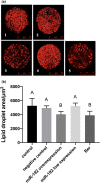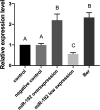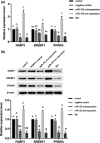Berberine regulates lipid metabolism via miR-192 in porcine oocytes matured in vitro
- PMID: 33818910
- PMCID: PMC8136937
- DOI: 10.1002/vms3.393
Berberine regulates lipid metabolism via miR-192 in porcine oocytes matured in vitro
Abstract
Background: The berberine (Ber) is an isoquinoline alkaloid compound extracted from Rhizoma coptidis and has the effect that reduces adipose. MicroRNA-192 (miR-192) is related to fat metabolism. However, the relevant mechanism of berberine on lipid metabolism during in vitro maturation (IVM) of porcine oocytes remains unclear.
Objectives: In this study, we investigated the molecular mechanism by which berberine promotes the IVM and lipid metabolism of porcine oocytes via miR-192.
Methods: Ber was added to IVM medium of porcine oocytes. MiR-192 agomir, miR-192 antagomir and negative control fragment were microinjected into the cytoplasm of oocytes without Ber. Rates of oocyte IVM and embryonic development in each group were observed. The content of lipid droplets in IVM oocytes in each group was analyzed by Nile red staining. Expression levels of miR-192 and FABP3, SREBF1 and PPARG, were detected by qPCR and western blotting. The target genes of miR-192 were determined by luciferase reporter assays.
Results and conclusions: We found that Ber significantly increased the rate of oocytes IVM and blastocyst development, and decreased the area and numbers of lipid droplets in IVM oocytes. Ber significantly increased the expression of miR-192 in IVM oocytes, and significantly decreased the expression of SREBF1 and PPARG, which were target genes of miR-192. This study indicates that Ber promotes lipid metabolism in porcine oocytes by activating the expression of miR-192 and down-regulating SREBF1 and PPARG, thus, improving IVM of porcine oocytes.
Keywords: berberine; in vitro maturation; lipid metabolism; miR-192; porcine oocyte.
© 2020 The Authors. Veterinary Medicine and Science published by John Wiley & Sons Ltd.
Conflict of interest statement
The authors declare no conflict of interest.
Figures




References
-
- Del, C. M. , Silveira, J. C. , Sangalli, J. R. , Andrade, G. M. , Sousa, L. R. D. S. , Silva, L. A. , & Perecin, F. (2017). Fatty acid binding protein 3 and transzonal projections are involved in lipid accumulation during in vitro maturation of bovine oocytes. Scientific Reports, 7, 2645. 10.1038/s41598-017-02467-9 - DOI - PMC - PubMed
-
- Dionysios, V. C. , Apostolos, Z. , Panos, G. Z. , Ralitsa, P. I. , Agathoklis, I. P. , Venetsana, E. K. , & Ioannis, G. H. (2012). Differential expression of MicroRNAs in adipose tissue after long‐term high‐fat diet‐induced obesity in mice. PLoS One, 7, e34872. 10.1371/journal.pone.0034872 - DOI - PMC - PubMed
-
- Esfandiar, H. , Mahmoud, R. K. , Abolfazle, K. , & Morteza, B. (2014). Metabolic effects of berberine on liver phosphatidate phosphohydrolase in rats fed on high lipogenic diet: An additional mechanism for the hypolipidemic effects of berberine. Asian Pacific Journal of Tropical Medicine, Z1, 429–435. 10.12980/APJTB.4.2014C474 - DOI - PMC - PubMed
Publication types
MeSH terms
Substances
LinkOut - more resources
Full Text Sources
Other Literature Sources
Miscellaneous

